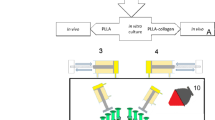Abstract
The demand for bone grafts has led to advances in regenerative engineering, a field at the intersection of advanced biomaterials, stem cell science, physics, developmental biology, and clinical translation. In this work, the authors evaluated a hybrid nanofiber/microsphere matrix both in vitro and in vivo for its ability to promote bone regeneration. Quantitative measures of cellular characteristics in vitro showed a higher fraction of marrow stromal cells with collagen promoter activity on hybrid matrices compared to control matrices (41 vs. 24%, p = 0.02). Control and hybrid matrices were then implanted for 6 weeks in calvarial defects of mice, and the animals received a single injection of calcein 1 day prior to sacrifice to visualize bone formation. Cryohistology of the undecalfied implants were evaluated for markers of bone mineralization, which revealed the evidence of higher levels of bone tissue formation in hybrid matrices compared to controls. These data provide support that nanofiber-permeated, sintered, composite microsphere matrices may be a particularly useful matrix for the regenerative engineering of bone.
Lay Summary
One idea to regenerate bone is to mimic the structure, composition, and feature size of natural human bone in a synthetic matrix to guide human stem cells. In this work, the authors combine an advanced material matrix with special genetically engineered stem cells to investigate if the special composition of the matrix can help improve existing matrices to support the regeneration of human bone. These results show that while the new matrices support a smaller population of cells, those cells are more likely to show evidence of growing into cells that may create bone.
Future Work
Future studies will include the implantation of transgenic, cell-seeded matrices of one fluorescent reporter mouse implanted in a host mouse that contains a separate fluorophore with a similar promoter. These studies will allow determination of the source of bone formation in these models: from host or from implant.




Similar content being viewed by others
References
Ma PX, Zhang R. Synthetic nano-scale fibrous extracellular matrix. J Biomed Mater Res. 1999;46:60–72.
Nelson C, Khan Y, Laurencin CT. Nanofiber-microsphere (nano-micro) matrices for bone regenerative engineering: a convergence approach toward matrix design. Regen Biomater. 2014;1:3–9.
Borden M, Attawia M, Khan Y, Laurencin CT. Tissue engineered microsphere-based matrices for bone repair: design and evaluation. Biomaterials. 2002;23(2):551–559.
Borden M, Attawia M, Laurencin CT. The sintered microsphere matrix for bone tissue engineering: in vitro osteoconductivity studies. J Biomed Mater Res. 2002;61:421–9.
Khan YM, Katti DS, Laurencin CT. Novel polymer-synthesized ceramic composite-based system for bone repair: an in vitro evaluation. J Biomed Mater Res A. 2004;69:728–37.
Brown JL, Peach MS, Nair LS, Kumbar SG, Laurencin CT. Composite scaffolds: bridging nanofiber and microsphere architectures to improve bioactivity of mechanically competent constructs. J Biomed Mater Res A. 2010;95:1150–8.
Czekanska EM, Stoddart MJ, Ralphs JR, Richards RG, Hayes JS. A phenotypic comparison of osteoblast cell lines versus human primary osteoblasts for biomaterials testing. J Biomed Mater Res A. 2014;102:2636–43.
Armstrong JJ, Larina IV, Dickinson ME, Zimmer WE, Hirschi KK. Characterization of bacterial artificial chromosome transgenic mice expressing mCherry fluorescent protein substituted for the murine smooth muscle alpha-actin gene. Genesis. 2010;48:457–63.
Kalajzic I, Kalajzic Z, Kaliterna M, Gronowicz G, Clark SH, Lichtler AC, et al. Use of type I collagen green fluorescent protein transgenes to identify subpopulations of cells at different stages of the osteoblast lineage. J Bone Miner Res. 2002;17:15–25.
Hayman D, Bergerson C, Miller S, Moreno M, Moore JE. The effect of static and dynamic loading on degradation of PLLA stent fibers. J Biomech Eng. 2014;136:081006.
Acknowledgements
The authors wish a special thanks to Nat Dyment and Max Villa for their help with Fiji and development of macros for fractional area measurements.
Funding
The authors wish to thank the Department of Defense for their sponsorship through grant DAMD W81XWH11-10262.
Author information
Authors and Affiliations
Corresponding author
Ethics declarations
All animal studies were accomplished in compliance with the Institutional Animal Care and Use Committee at the University of Connecticut Health Center.
Rights and permissions
About this article
Cite this article
Nelson, C., Khan, Y. & Laurencin, C.T. Nanofiber/Microsphere Hybrid Matrices In Vivo for Bone Regenerative Engineering: A Preliminary Report. Regen. Eng. Transl. Med. 4, 133–141 (2018). https://doi.org/10.1007/s40883-018-0055-1
Received:
Accepted:
Published:
Issue Date:
DOI: https://doi.org/10.1007/s40883-018-0055-1




